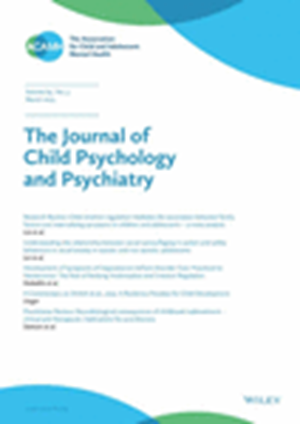A person-centered and genetically informed approach toward characterizing multidomain resilience to neighborhood disadvantage in youth.
IF 7
1区 医学
Q1 PSYCHIATRY
引用次数: 0
Abstract
BACKGROUND Examining resilience to adversity across multiple behavioral domains (e.g., psychological well-being, social functioning) can better characterize positive development and inform novel prevention and intervention efforts. However, few studies have employed person-centered methods to examine individual profiles of resilience across multiple domains in youth. Further, research exploring contextual predictors of resilience has rarely used genetically informed designs, which are critical for eliminating potential confounds. METHODS The current study employed latent profile analysis (LPA) to extract profiles of resilience across psychological, social, and academic domains in 708 adolescent twins exposed to neighborhood disadvantage, a pervasive form of early life adversity. Next, associations between profile membership and parenting, peer, and neighborhood social processes were examined. Lastly, co-twin control analyses were conducted to explore whether associations between resilience profile membership and social processes were environmental versus genetic in origin. RESULTS Youth were grouped into three resilience profiles: (1) High Multidomain Resilience (63%), (2) Low Psychological Resilience, High Social Resilience (19%), and (3) Low Multidomain Resilience (18%). Profiles differed in experiences of parenting (i.e., parental involvement, conflict), peer characteristics (i.e., friend drug-related behaviors, popularity), and neighborhood processes (i.e., social cohesion, informal social control, positive social norms). Follow-up analyses within-twin pairs revealed that the association between higher resilience and parenting (higher nurturance, lower conflict) was at least partially environmental in origin. CONCLUSIONS Youth show distinct profiles of resilience across psychological, social, and academic domains, which are uniquely related to processes at the family, peer, and neighborhood level. Further, the association between resilience and parenting is in part environmentally mediated, suggesting a modifiable pathway to boost resilience in adolescents exposed to neighborhood disadvantage.一个以人为中心和遗传信息的方法来表征青年对邻里不利的多领域弹性。
研究跨多个行为领域(如心理健康、社会功能)的逆境复原力可以更好地表征积极发展,并为新的预防和干预措施提供信息。然而,很少有研究采用以人为中心的方法来检查青年跨多个领域的弹性个人概况。此外,研究探索弹性的上下文预测因素很少使用遗传信息设计,这对于消除潜在的混淆至关重要。方法本研究采用潜在剖面分析(LPA)提取708名暴露于邻里劣势(一种普遍存在的早期生活逆境)的青春期双胞胎在心理、社会和学术领域的弹性特征。接下来,研究了档案成员与父母、同伴和邻里社会过程之间的关系。最后,进行了双胞对照分析,以探讨弹性概况成员与社会过程之间的关联是环境的还是遗传的。结果青少年心理弹性分为高多领域弹性(63%)、低心理弹性(19%)、高社会弹性(19%)和低多领域弹性(18%)3个类型。在育儿经历(即父母参与、冲突)、同伴特征(即朋友毒品相关行为、受欢迎程度)和邻里关系过程(即社会凝聚力、非正式社会控制、积极社会规范)方面,这些特征存在差异。对双胞胎的后续分析显示,高韧性和父母教养(高教养,低冲突)之间的联系至少部分源于环境。结论青少年在心理、社会和学术领域均表现出明显的弹性特征,这些特征与家庭、同伴和邻里水平的过程有独特的关系。此外,适应力和养育之间的联系部分是由环境介导的,这表明有一种可改变的途径来提高处于弱势社区的青少年的适应力。
本文章由计算机程序翻译,如有差异,请以英文原文为准。
求助全文
约1分钟内获得全文
求助全文
来源期刊
CiteScore
13.80
自引率
5.30%
发文量
169
审稿时长
1 months
期刊介绍:
The Journal of Child Psychology and Psychiatry (JCPP) is a highly regarded international publication that focuses on the fields of child and adolescent psychology and psychiatry. It is recognized for publishing top-tier, clinically relevant research across various disciplines related to these areas. JCPP has a broad global readership and covers a diverse range of topics, including:
Epidemiology: Studies on the prevalence and distribution of mental health issues in children and adolescents.
Diagnosis: Research on the identification and classification of childhood disorders.
Treatments: Psychotherapeutic and psychopharmacological interventions for child and adolescent mental health.
Behavior and Cognition: Studies on the behavioral and cognitive aspects of childhood disorders.
Neuroscience and Neurobiology: Research on the neural and biological underpinnings of child mental health.
Genetics: Genetic factors contributing to the development of childhood disorders.
JCPP serves as a platform for integrating empirical research, clinical studies, and high-quality reviews from diverse perspectives, theoretical viewpoints, and disciplines. This interdisciplinary approach is a key feature of the journal, as it fosters a comprehensive understanding of child and adolescent mental health.
The Journal of Child Psychology and Psychiatry is published 12 times a year and is affiliated with the Association for Child and Adolescent Mental Health (ACAMH), which supports the journal's mission to advance knowledge and practice in the field of child and adolescent mental health.

 求助内容:
求助内容: 应助结果提醒方式:
应助结果提醒方式:


